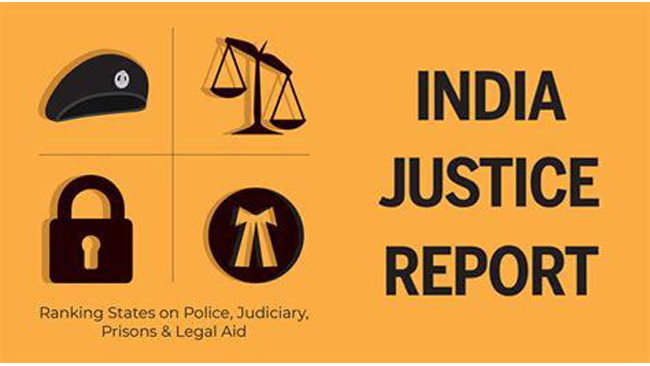
The second edition of the India Justice Report is all about comparisons
and tracking the rise and falls in each state’s structural and financial
capacity to deliver justice. Using the latest available government figures the
first ever ranking was published in November 2019. The ranking is based on a
quantitative measurement of budgets, human resources, infrastructure, workload
and diversity across police, judiciary, prisons and legal aid in 18 large and
medium sized states with a population of over 1 crore and 7 small states. Data
for 7 Union Territories (UTs) and 4 states is also provided. The IJR 2020 only
provides pillar and theme wise comparisons between similarly situated states
one against another, but also allows for an understanding of what improvements
and shortfalls have been made within each state’s own pillars and themes since
IJR 2019 and over 5 years. These mark out clear discernible trends and
directions.
Most large and mid-sized states spent
between 3% and 5% of their total budget on policing. Certain states, owing to
their special circumstances, spent as much as 6-13%. Between the financial
years 2015-16 and 2017-18, state expenditure on police and prisons have seen a
decline. Against this, expenditure on the judiciary increased 0.56% to 0.58%
and on legal aid from 0.011% to 0.014%.
As was shown in IJR 2019, in most
states, the increase in spending on these pillars of justice is not keeping
pace with the increase in the size of the overall state expenditure. Of the
ranked states, between 2013-14 and 2017-18, only 7 increased their police
expenditure over state expenditure. This figure was 13 states in the previous
report. The judiciary saw improved expenditure by 4 states compared to IJR
2019—8 states now show an increase in expenditure on the judiciary outpacing
increase in state expenditure. While no large state’s police, prison and
judiciary expenditures were able to increase at a pace higher than the increase
in overall state expenditure, Meghalaya and Arunachal Pradesh amongst small
states demonstrated this.
So, for example, the average 5-year
increase in Bihar’s police spend was 11.93%, while its overall expenditure increased
15.56%—a difference of -3.63 percentage points.
India spends ₹1 per
capita on legal aid
Almost 80 per cent of India’s over
1.3 billion population is eligible for free legal aid, yet according to the
latest figures, India spends only ₹1 per capita on legal aid. These are just
some of the findings of the latest India Justice Report 2020, supported by the
Tata Trusts.
Data for Police Modernization Fund
utilization in 2019–20shows an overall decline in the average utilization compared
to 2017—falling from 75% to 41%. West Bengal, Mizoram and Nagaland were the
only states able to utilize 100% of the fund. Odisha (10%) and Tripura (2%)
could utilize 10% or less while Manipur, Meghalaya, Punjab, Chhattisgarh,
Andhra Pradesh and Madhya Pradesh did not use any.
Utilization of allocated funds
fluctuates between beyond 100 per cent (Telangana) to as low as 50%
(Meghalaya). Overall though, over a three-year period states/ UTs have done
worse in terms of utilization: Gujarat fell from 95% to 80%; Uttar Pradesh from
94% to 83%; and Meghalaya from 88% to 50%. By contrast, Telangana (92%to 103%)
and Tripura (75% to 99%) are amongst the states to have improved their
utilisation.
In legal aid, nationally, utilization
improved from 70.7% to 94.07%; while for large and mid-sized states moved from
77.13% to 96.02% in the 18 large and mid-sized states with eight of them
utilising at least 90% of this central fund. Uttar Pradesh utilised near 100%.
Meghalaya, was the only state to have used only roughly one fourth of the funds
allocated. However, the National Legal Services Authority’s own budget fell
from 150 crore for 2018-2019 to 100 crore for 2020-2021.
As of 2019–20, unlike a year ago, all
states have contributed towards legal services expenditure, while others have
increased their share. The increased willingness to contribute more towards
legal aid suggests a mounting recognition of the value of this service. In
seven states, this share has moved to upwards of 80%; in IJR 2019, only Andhra
Pradesh, Gujarat and Uttar Pradesh contributed this amount. With more funds to
hand states’ utilization has also gone up.
Low expenditure on police training
Training accounts for a mere 1.13% of the total national spend on policing or roughly ₹8,000 per police person. This varies a great deal from state to state. Mizoram, with a force of over 5,406, spends the highest at about ₹32,310 per head. This is followed by Delhi (₹24,809) and Bihar (₹15,745). According to BPR&D data, Kerala, with nearly 53,000 personnel, spends nothing while Tamil Nadu spends ₹2. Among the small states Himachal Pradesh spends the least (₹511).
Spending on inmates has improved
Nationally, the average spend per
prisoner has, however, gone up by nearly 45 per cent. Andhra Pradesh, at ₹2,00,000
for over 7,500 inmates in 106 prisons records the highest annual spend. Fifteen
out of thirty-six states/ UTs spent less on a prisoner in 2019-20 than in
2016-17.
In 2019-20, seventeen states/ UTs spent below ₹35,000 annually, or less than ₹100 a day per person. But the lowest spends per prisoner have gone down further: in 2016-17 Rajasthan at ₹14,700 spent the least per inmate but, currently, at ₹11,000 Meghalaya spends the least per inmate.